An Overview of Risk Assessment Techniques in Corporate Finance
VerifiedAdded on 2020/03/23
|10
|2660
|37
Report
AI Summary
This report provides a comprehensive overview of risk assessment techniques used in capital budgeting. It begins with an introduction to capital budgeting and its stages, emphasizing the importance of evaluating investment projects. The report then delves into four key risk assessment techniques: sensitivity analysis, scenario analysis, break-even analysis, and simulation techniques. Sensitivity analysis explores how changes in variables affect a project's Net Present Value (NPV) or Internal Rate of Return (IRR). Scenario analysis expands on this by considering multiple variables simultaneously to provide a range of possible outcomes. Break-even analysis focuses on the relationship between profitability and sales volume, helping managers determine the sales volume needed for a project to become profitable. Finally, simulation techniques use statistical tools to model the distribution of potential outcomes, providing a more comprehensive understanding of investment risks. The report concludes by highlighting the importance of these techniques in making informed capital budgeting decisions.

Corporate Financial Management
Paraphrase This Document
Need a fresh take? Get an instant paraphrase of this document with our AI Paraphraser

Table of Contents
Introduction................................................................................................................................3
Techniques of Risk Assessment.................................................................................................4
Sensitivity Analysis................................................................................................................4
Scenario Analysis...................................................................................................................6
Break-Even Analysis..............................................................................................................7
Simulation Techniques...........................................................................................................8
Conclusion..................................................................................................................................9
References..................................................................................................................................9
Introduction................................................................................................................................3
Techniques of Risk Assessment.................................................................................................4
Sensitivity Analysis................................................................................................................4
Scenario Analysis...................................................................................................................6
Break-Even Analysis..............................................................................................................7
Simulation Techniques...........................................................................................................8
Conclusion..................................................................................................................................9
References..................................................................................................................................9
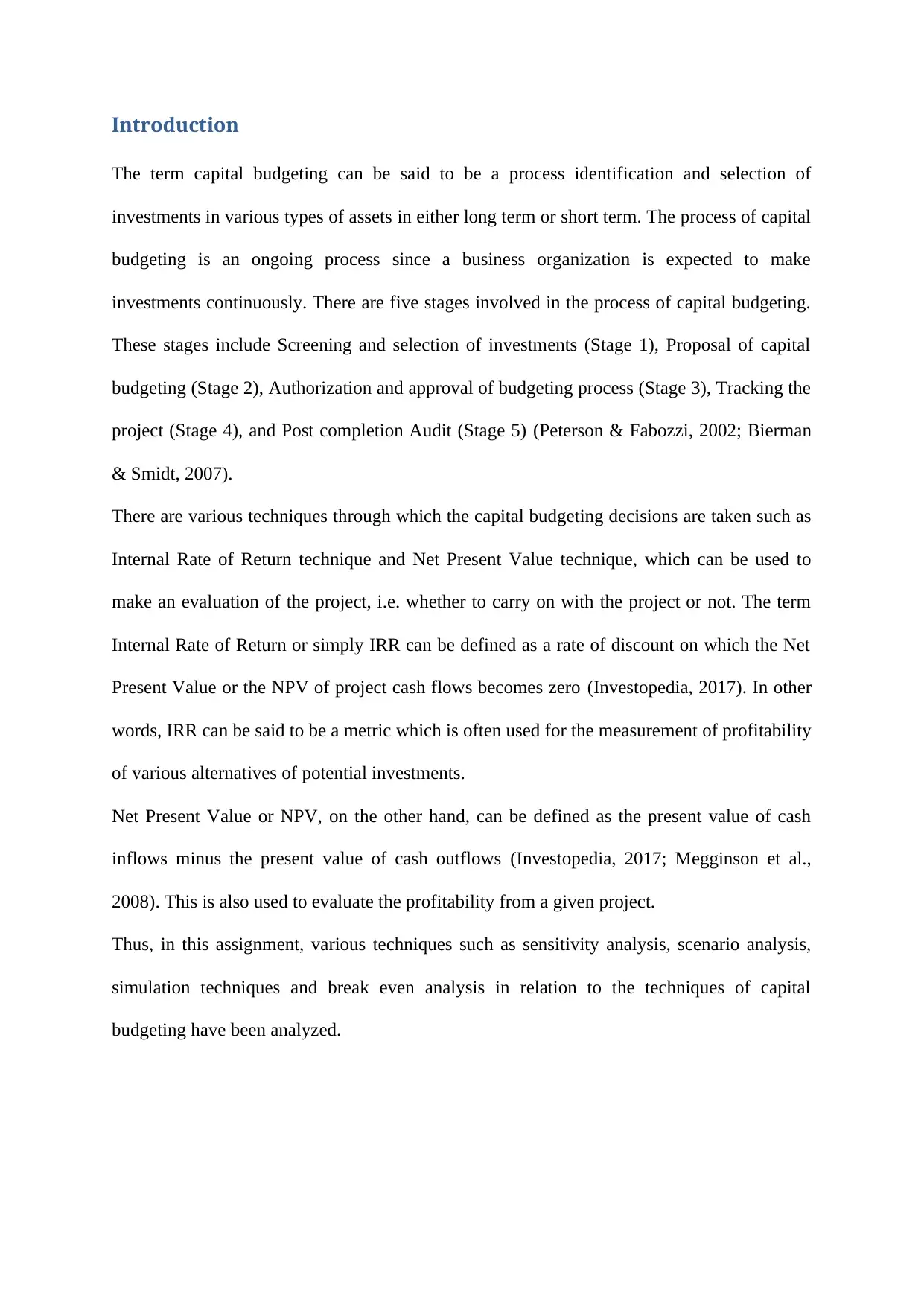
Introduction
The term capital budgeting can be said to be a process identification and selection of
investments in various types of assets in either long term or short term. The process of capital
budgeting is an ongoing process since a business organization is expected to make
investments continuously. There are five stages involved in the process of capital budgeting.
These stages include Screening and selection of investments (Stage 1), Proposal of capital
budgeting (Stage 2), Authorization and approval of budgeting process (Stage 3), Tracking the
project (Stage 4), and Post completion Audit (Stage 5) (Peterson & Fabozzi, 2002; Bierman
& Smidt, 2007).
There are various techniques through which the capital budgeting decisions are taken such as
Internal Rate of Return technique and Net Present Value technique, which can be used to
make an evaluation of the project, i.e. whether to carry on with the project or not. The term
Internal Rate of Return or simply IRR can be defined as a rate of discount on which the Net
Present Value or the NPV of project cash flows becomes zero (Investopedia, 2017). In other
words, IRR can be said to be a metric which is often used for the measurement of profitability
of various alternatives of potential investments.
Net Present Value or NPV, on the other hand, can be defined as the present value of cash
inflows minus the present value of cash outflows (Investopedia, 2017; Megginson et al.,
2008). This is also used to evaluate the profitability from a given project.
Thus, in this assignment, various techniques such as sensitivity analysis, scenario analysis,
simulation techniques and break even analysis in relation to the techniques of capital
budgeting have been analyzed.
The term capital budgeting can be said to be a process identification and selection of
investments in various types of assets in either long term or short term. The process of capital
budgeting is an ongoing process since a business organization is expected to make
investments continuously. There are five stages involved in the process of capital budgeting.
These stages include Screening and selection of investments (Stage 1), Proposal of capital
budgeting (Stage 2), Authorization and approval of budgeting process (Stage 3), Tracking the
project (Stage 4), and Post completion Audit (Stage 5) (Peterson & Fabozzi, 2002; Bierman
& Smidt, 2007).
There are various techniques through which the capital budgeting decisions are taken such as
Internal Rate of Return technique and Net Present Value technique, which can be used to
make an evaluation of the project, i.e. whether to carry on with the project or not. The term
Internal Rate of Return or simply IRR can be defined as a rate of discount on which the Net
Present Value or the NPV of project cash flows becomes zero (Investopedia, 2017). In other
words, IRR can be said to be a metric which is often used for the measurement of profitability
of various alternatives of potential investments.
Net Present Value or NPV, on the other hand, can be defined as the present value of cash
inflows minus the present value of cash outflows (Investopedia, 2017; Megginson et al.,
2008). This is also used to evaluate the profitability from a given project.
Thus, in this assignment, various techniques such as sensitivity analysis, scenario analysis,
simulation techniques and break even analysis in relation to the techniques of capital
budgeting have been analyzed.
⊘ This is a preview!⊘
Do you want full access?
Subscribe today to unlock all pages.

Trusted by 1+ million students worldwide
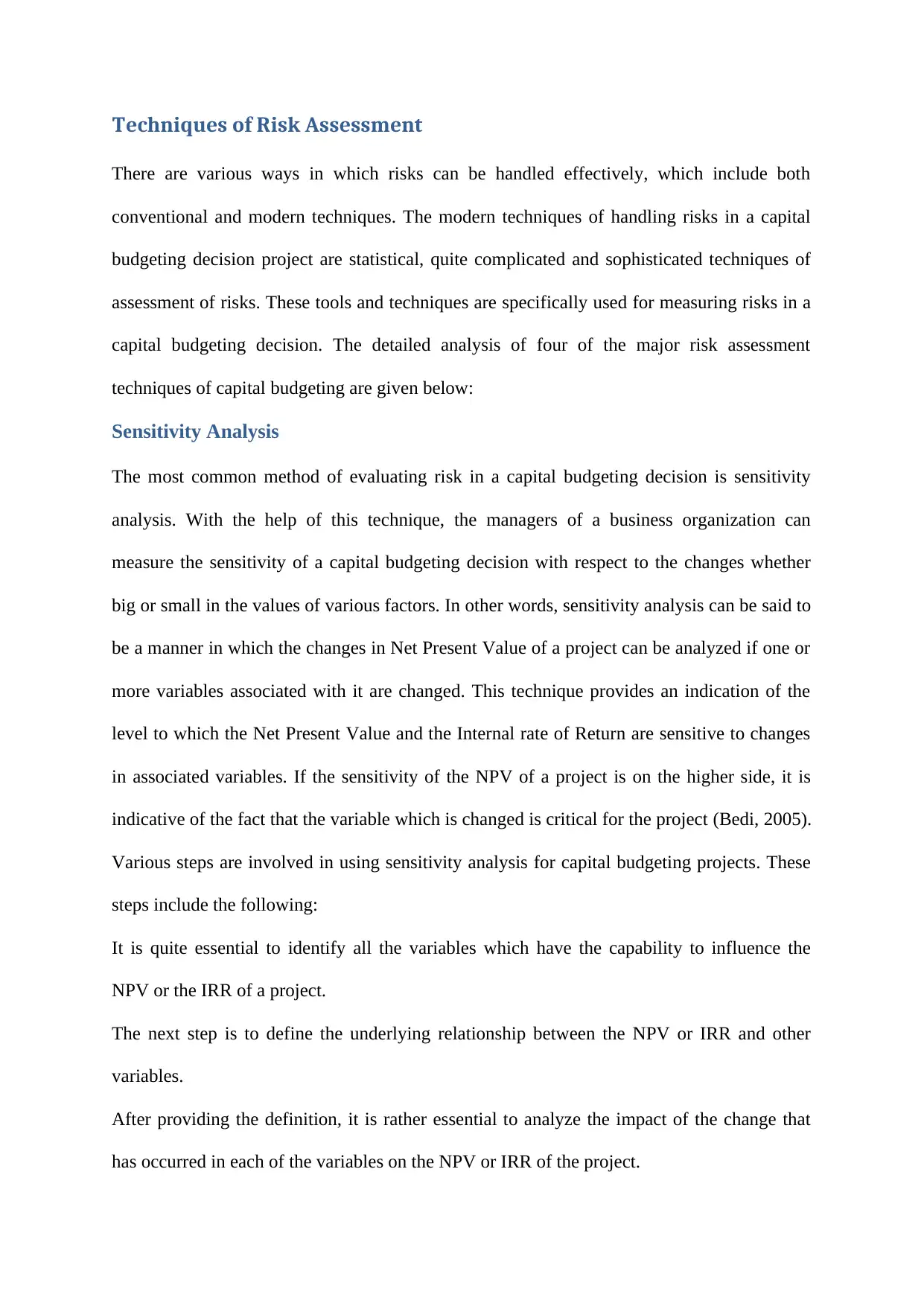
Techniques of Risk Assessment
There are various ways in which risks can be handled effectively, which include both
conventional and modern techniques. The modern techniques of handling risks in a capital
budgeting decision project are statistical, quite complicated and sophisticated techniques of
assessment of risks. These tools and techniques are specifically used for measuring risks in a
capital budgeting decision. The detailed analysis of four of the major risk assessment
techniques of capital budgeting are given below:
Sensitivity Analysis
The most common method of evaluating risk in a capital budgeting decision is sensitivity
analysis. With the help of this technique, the managers of a business organization can
measure the sensitivity of a capital budgeting decision with respect to the changes whether
big or small in the values of various factors. In other words, sensitivity analysis can be said to
be a manner in which the changes in Net Present Value of a project can be analyzed if one or
more variables associated with it are changed. This technique provides an indication of the
level to which the Net Present Value and the Internal rate of Return are sensitive to changes
in associated variables. If the sensitivity of the NPV of a project is on the higher side, it is
indicative of the fact that the variable which is changed is critical for the project (Bedi, 2005).
Various steps are involved in using sensitivity analysis for capital budgeting projects. These
steps include the following:
It is quite essential to identify all the variables which have the capability to influence the
NPV or the IRR of a project.
The next step is to define the underlying relationship between the NPV or IRR and other
variables.
After providing the definition, it is rather essential to analyze the impact of the change that
has occurred in each of the variables on the NPV or IRR of the project.
There are various ways in which risks can be handled effectively, which include both
conventional and modern techniques. The modern techniques of handling risks in a capital
budgeting decision project are statistical, quite complicated and sophisticated techniques of
assessment of risks. These tools and techniques are specifically used for measuring risks in a
capital budgeting decision. The detailed analysis of four of the major risk assessment
techniques of capital budgeting are given below:
Sensitivity Analysis
The most common method of evaluating risk in a capital budgeting decision is sensitivity
analysis. With the help of this technique, the managers of a business organization can
measure the sensitivity of a capital budgeting decision with respect to the changes whether
big or small in the values of various factors. In other words, sensitivity analysis can be said to
be a manner in which the changes in Net Present Value of a project can be analyzed if one or
more variables associated with it are changed. This technique provides an indication of the
level to which the Net Present Value and the Internal rate of Return are sensitive to changes
in associated variables. If the sensitivity of the NPV of a project is on the higher side, it is
indicative of the fact that the variable which is changed is critical for the project (Bedi, 2005).
Various steps are involved in using sensitivity analysis for capital budgeting projects. These
steps include the following:
It is quite essential to identify all the variables which have the capability to influence the
NPV or the IRR of a project.
The next step is to define the underlying relationship between the NPV or IRR and other
variables.
After providing the definition, it is rather essential to analyze the impact of the change that
has occurred in each of the variables on the NPV or IRR of the project.
Paraphrase This Document
Need a fresh take? Get an instant paraphrase of this document with our AI Paraphraser
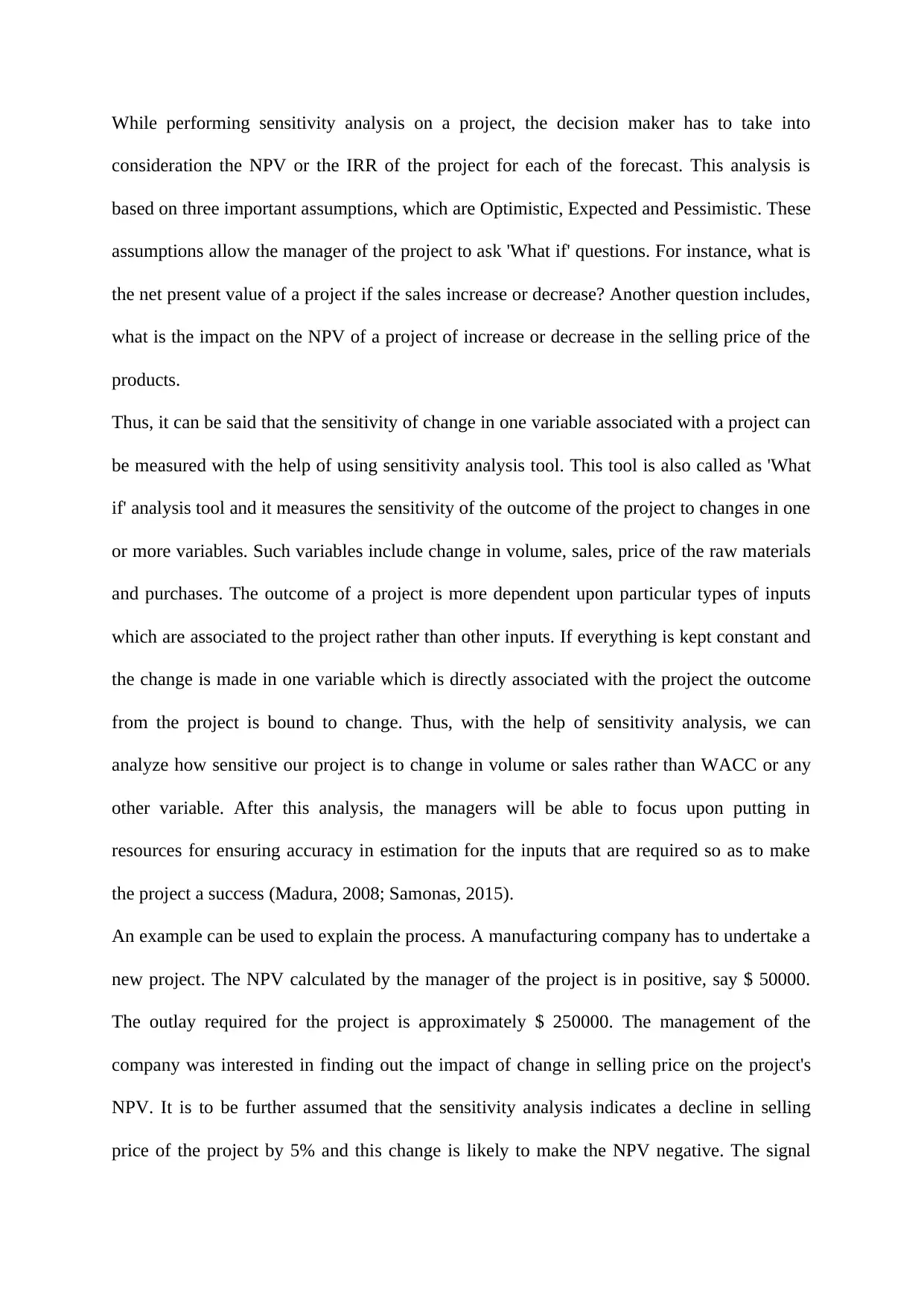
While performing sensitivity analysis on a project, the decision maker has to take into
consideration the NPV or the IRR of the project for each of the forecast. This analysis is
based on three important assumptions, which are Optimistic, Expected and Pessimistic. These
assumptions allow the manager of the project to ask 'What if' questions. For instance, what is
the net present value of a project if the sales increase or decrease? Another question includes,
what is the impact on the NPV of a project of increase or decrease in the selling price of the
products.
Thus, it can be said that the sensitivity of change in one variable associated with a project can
be measured with the help of using sensitivity analysis tool. This tool is also called as 'What
if' analysis tool and it measures the sensitivity of the outcome of the project to changes in one
or more variables. Such variables include change in volume, sales, price of the raw materials
and purchases. The outcome of a project is more dependent upon particular types of inputs
which are associated to the project rather than other inputs. If everything is kept constant and
the change is made in one variable which is directly associated with the project the outcome
from the project is bound to change. Thus, with the help of sensitivity analysis, we can
analyze how sensitive our project is to change in volume or sales rather than WACC or any
other variable. After this analysis, the managers will be able to focus upon putting in
resources for ensuring accuracy in estimation for the inputs that are required so as to make
the project a success (Madura, 2008; Samonas, 2015).
An example can be used to explain the process. A manufacturing company has to undertake a
new project. The NPV calculated by the manager of the project is in positive, say $ 50000.
The outlay required for the project is approximately $ 250000. The management of the
company was interested in finding out the impact of change in selling price on the project's
NPV. It is to be further assumed that the sensitivity analysis indicates a decline in selling
price of the project by 5% and this change is likely to make the NPV negative. The signal
consideration the NPV or the IRR of the project for each of the forecast. This analysis is
based on three important assumptions, which are Optimistic, Expected and Pessimistic. These
assumptions allow the manager of the project to ask 'What if' questions. For instance, what is
the net present value of a project if the sales increase or decrease? Another question includes,
what is the impact on the NPV of a project of increase or decrease in the selling price of the
products.
Thus, it can be said that the sensitivity of change in one variable associated with a project can
be measured with the help of using sensitivity analysis tool. This tool is also called as 'What
if' analysis tool and it measures the sensitivity of the outcome of the project to changes in one
or more variables. Such variables include change in volume, sales, price of the raw materials
and purchases. The outcome of a project is more dependent upon particular types of inputs
which are associated to the project rather than other inputs. If everything is kept constant and
the change is made in one variable which is directly associated with the project the outcome
from the project is bound to change. Thus, with the help of sensitivity analysis, we can
analyze how sensitive our project is to change in volume or sales rather than WACC or any
other variable. After this analysis, the managers will be able to focus upon putting in
resources for ensuring accuracy in estimation for the inputs that are required so as to make
the project a success (Madura, 2008; Samonas, 2015).
An example can be used to explain the process. A manufacturing company has to undertake a
new project. The NPV calculated by the manager of the project is in positive, say $ 50000.
The outlay required for the project is approximately $ 250000. The management of the
company was interested in finding out the impact of change in selling price on the project's
NPV. It is to be further assumed that the sensitivity analysis indicates a decline in selling
price of the project by 5% and this change is likely to make the NPV negative. The signal
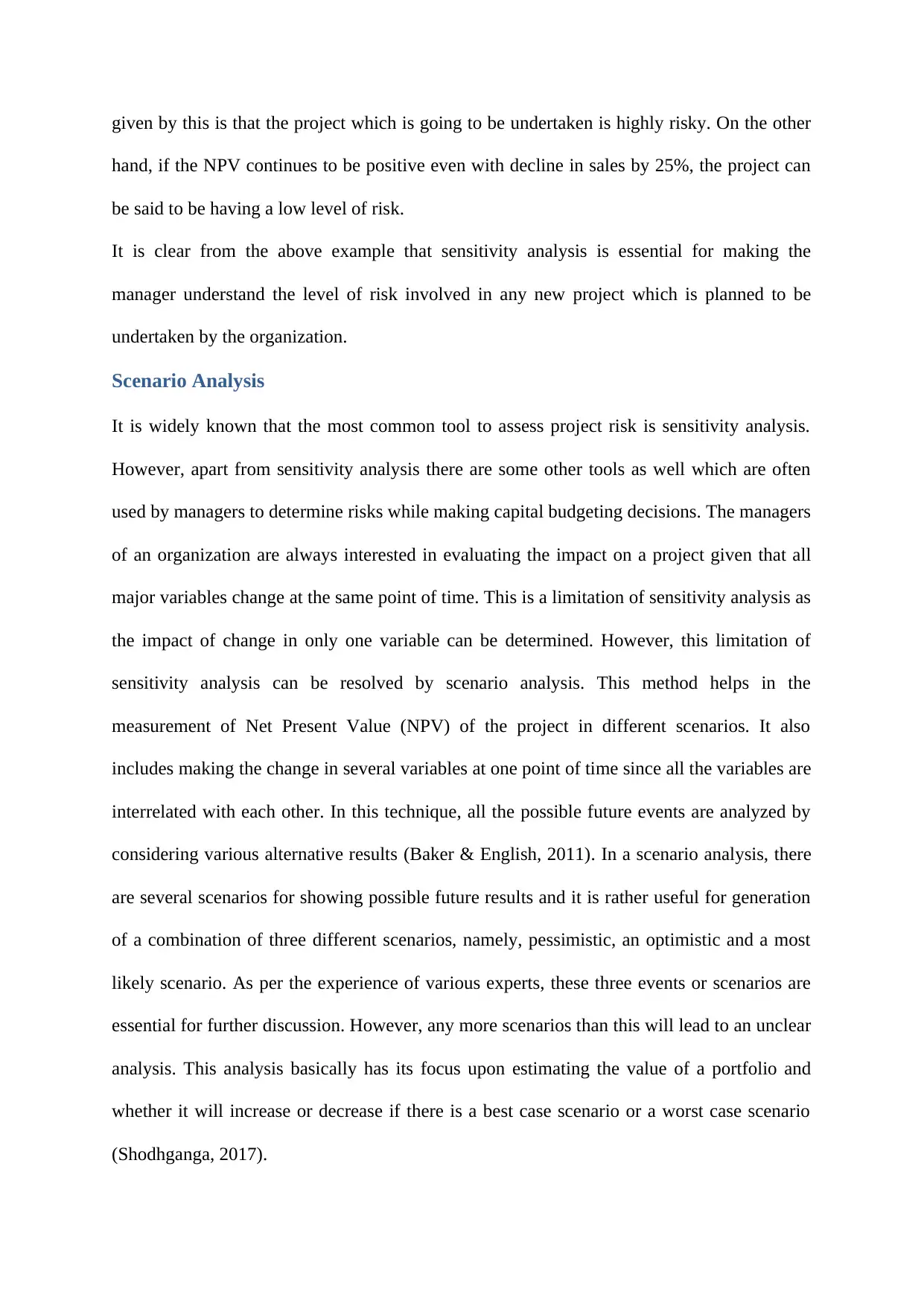
given by this is that the project which is going to be undertaken is highly risky. On the other
hand, if the NPV continues to be positive even with decline in sales by 25%, the project can
be said to be having a low level of risk.
It is clear from the above example that sensitivity analysis is essential for making the
manager understand the level of risk involved in any new project which is planned to be
undertaken by the organization.
Scenario Analysis
It is widely known that the most common tool to assess project risk is sensitivity analysis.
However, apart from sensitivity analysis there are some other tools as well which are often
used by managers to determine risks while making capital budgeting decisions. The managers
of an organization are always interested in evaluating the impact on a project given that all
major variables change at the same point of time. This is a limitation of sensitivity analysis as
the impact of change in only one variable can be determined. However, this limitation of
sensitivity analysis can be resolved by scenario analysis. This method helps in the
measurement of Net Present Value (NPV) of the project in different scenarios. It also
includes making the change in several variables at one point of time since all the variables are
interrelated with each other. In this technique, all the possible future events are analyzed by
considering various alternative results (Baker & English, 2011). In a scenario analysis, there
are several scenarios for showing possible future results and it is rather useful for generation
of a combination of three different scenarios, namely, pessimistic, an optimistic and a most
likely scenario. As per the experience of various experts, these three events or scenarios are
essential for further discussion. However, any more scenarios than this will lead to an unclear
analysis. This analysis basically has its focus upon estimating the value of a portfolio and
whether it will increase or decrease if there is a best case scenario or a worst case scenario
(Shodhganga, 2017).
hand, if the NPV continues to be positive even with decline in sales by 25%, the project can
be said to be having a low level of risk.
It is clear from the above example that sensitivity analysis is essential for making the
manager understand the level of risk involved in any new project which is planned to be
undertaken by the organization.
Scenario Analysis
It is widely known that the most common tool to assess project risk is sensitivity analysis.
However, apart from sensitivity analysis there are some other tools as well which are often
used by managers to determine risks while making capital budgeting decisions. The managers
of an organization are always interested in evaluating the impact on a project given that all
major variables change at the same point of time. This is a limitation of sensitivity analysis as
the impact of change in only one variable can be determined. However, this limitation of
sensitivity analysis can be resolved by scenario analysis. This method helps in the
measurement of Net Present Value (NPV) of the project in different scenarios. It also
includes making the change in several variables at one point of time since all the variables are
interrelated with each other. In this technique, all the possible future events are analyzed by
considering various alternative results (Baker & English, 2011). In a scenario analysis, there
are several scenarios for showing possible future results and it is rather useful for generation
of a combination of three different scenarios, namely, pessimistic, an optimistic and a most
likely scenario. As per the experience of various experts, these three events or scenarios are
essential for further discussion. However, any more scenarios than this will lead to an unclear
analysis. This analysis basically has its focus upon estimating the value of a portfolio and
whether it will increase or decrease if there is a best case scenario or a worst case scenario
(Shodhganga, 2017).
⊘ This is a preview!⊘
Do you want full access?
Subscribe today to unlock all pages.

Trusted by 1+ million students worldwide
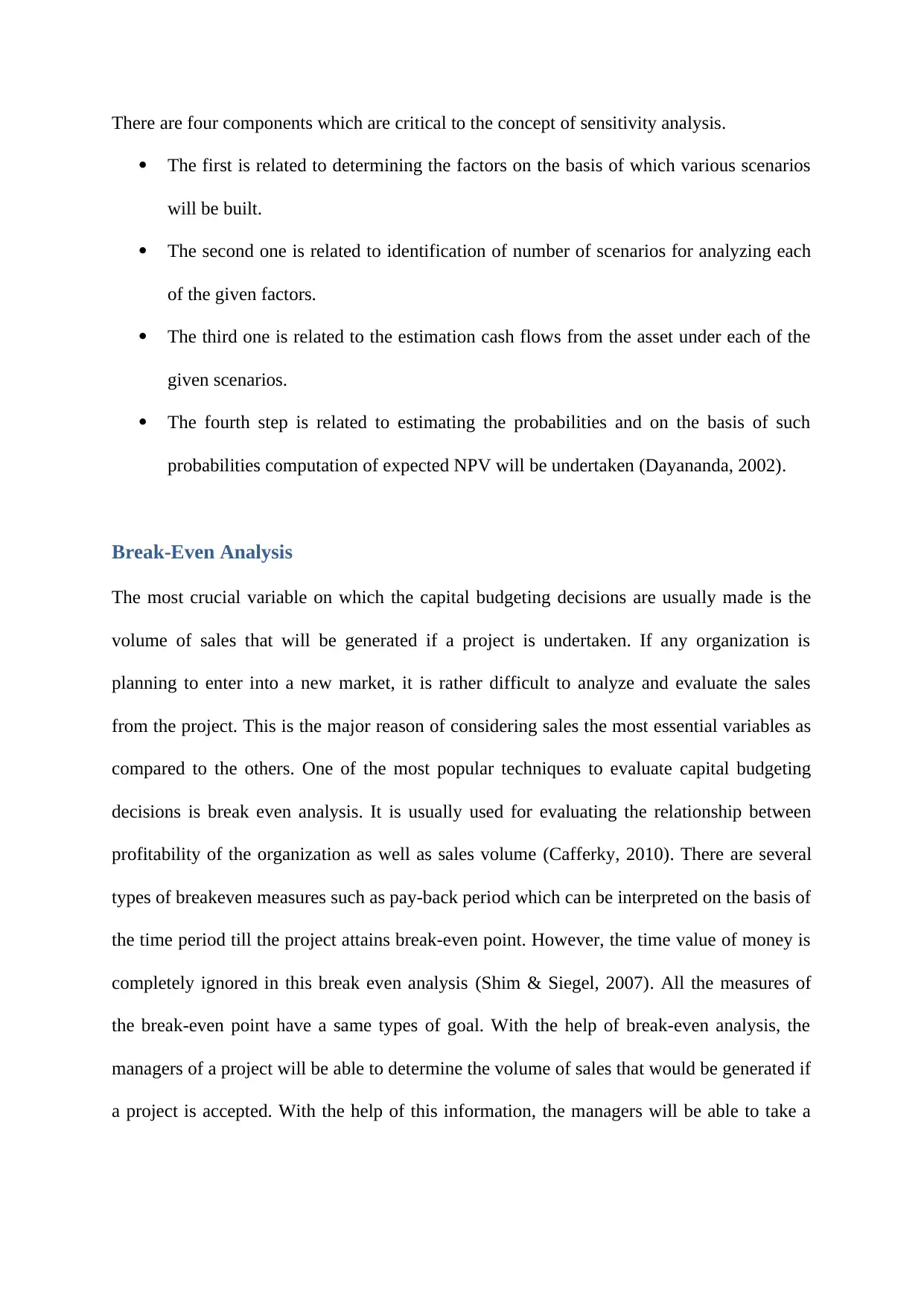
There are four components which are critical to the concept of sensitivity analysis.
The first is related to determining the factors on the basis of which various scenarios
will be built.
The second one is related to identification of number of scenarios for analyzing each
of the given factors.
The third one is related to the estimation cash flows from the asset under each of the
given scenarios.
The fourth step is related to estimating the probabilities and on the basis of such
probabilities computation of expected NPV will be undertaken (Dayananda, 2002).
Break-Even Analysis
The most crucial variable on which the capital budgeting decisions are usually made is the
volume of sales that will be generated if a project is undertaken. If any organization is
planning to enter into a new market, it is rather difficult to analyze and evaluate the sales
from the project. This is the major reason of considering sales the most essential variables as
compared to the others. One of the most popular techniques to evaluate capital budgeting
decisions is break even analysis. It is usually used for evaluating the relationship between
profitability of the organization as well as sales volume (Cafferky, 2010). There are several
types of breakeven measures such as pay-back period which can be interpreted on the basis of
the time period till the project attains break-even point. However, the time value of money is
completely ignored in this break even analysis (Shim & Siegel, 2007). All the measures of
the break-even point have a same types of goal. With the help of break-even analysis, the
managers of a project will be able to determine the volume of sales that would be generated if
a project is accepted. With the help of this information, the managers will be able to take a
The first is related to determining the factors on the basis of which various scenarios
will be built.
The second one is related to identification of number of scenarios for analyzing each
of the given factors.
The third one is related to the estimation cash flows from the asset under each of the
given scenarios.
The fourth step is related to estimating the probabilities and on the basis of such
probabilities computation of expected NPV will be undertaken (Dayananda, 2002).
Break-Even Analysis
The most crucial variable on which the capital budgeting decisions are usually made is the
volume of sales that will be generated if a project is undertaken. If any organization is
planning to enter into a new market, it is rather difficult to analyze and evaluate the sales
from the project. This is the major reason of considering sales the most essential variables as
compared to the others. One of the most popular techniques to evaluate capital budgeting
decisions is break even analysis. It is usually used for evaluating the relationship between
profitability of the organization as well as sales volume (Cafferky, 2010). There are several
types of breakeven measures such as pay-back period which can be interpreted on the basis of
the time period till the project attains break-even point. However, the time value of money is
completely ignored in this break even analysis (Shim & Siegel, 2007). All the measures of
the break-even point have a same types of goal. With the help of break-even analysis, the
managers of a project will be able to determine the volume of sales that would be generated if
a project is accepted. With the help of this information, the managers will be able to take a
Paraphrase This Document
Need a fresh take? Get an instant paraphrase of this document with our AI Paraphraser
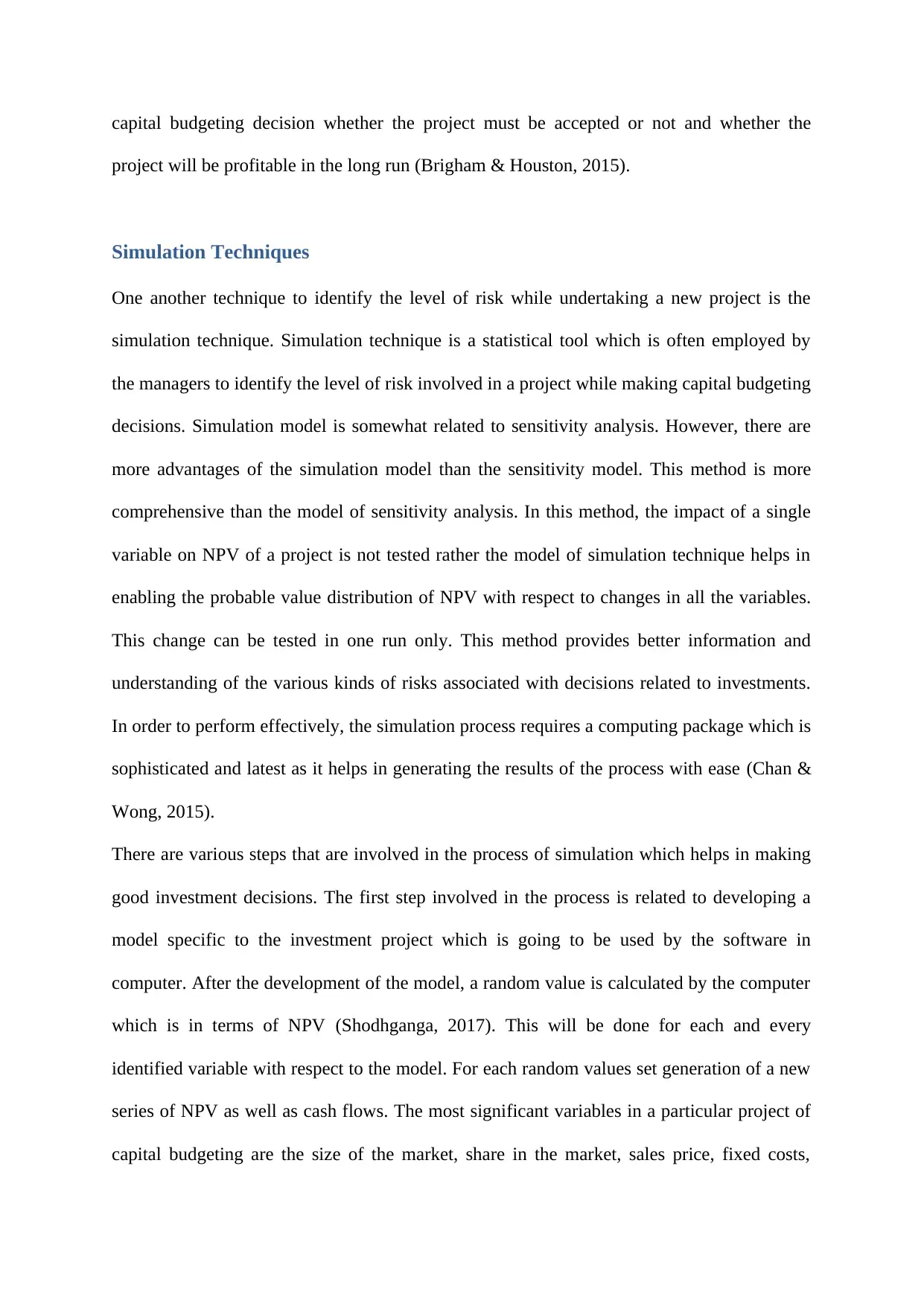
capital budgeting decision whether the project must be accepted or not and whether the
project will be profitable in the long run (Brigham & Houston, 2015).
Simulation Techniques
One another technique to identify the level of risk while undertaking a new project is the
simulation technique. Simulation technique is a statistical tool which is often employed by
the managers to identify the level of risk involved in a project while making capital budgeting
decisions. Simulation model is somewhat related to sensitivity analysis. However, there are
more advantages of the simulation model than the sensitivity model. This method is more
comprehensive than the model of sensitivity analysis. In this method, the impact of a single
variable on NPV of a project is not tested rather the model of simulation technique helps in
enabling the probable value distribution of NPV with respect to changes in all the variables.
This change can be tested in one run only. This method provides better information and
understanding of the various kinds of risks associated with decisions related to investments.
In order to perform effectively, the simulation process requires a computing package which is
sophisticated and latest as it helps in generating the results of the process with ease (Chan &
Wong, 2015).
There are various steps that are involved in the process of simulation which helps in making
good investment decisions. The first step involved in the process is related to developing a
model specific to the investment project which is going to be used by the software in
computer. After the development of the model, a random value is calculated by the computer
which is in terms of NPV (Shodhganga, 2017). This will be done for each and every
identified variable with respect to the model. For each random values set generation of a new
series of NPV as well as cash flows. The most significant variables in a particular project of
capital budgeting are the size of the market, share in the market, sales price, fixed costs,
project will be profitable in the long run (Brigham & Houston, 2015).
Simulation Techniques
One another technique to identify the level of risk while undertaking a new project is the
simulation technique. Simulation technique is a statistical tool which is often employed by
the managers to identify the level of risk involved in a project while making capital budgeting
decisions. Simulation model is somewhat related to sensitivity analysis. However, there are
more advantages of the simulation model than the sensitivity model. This method is more
comprehensive than the model of sensitivity analysis. In this method, the impact of a single
variable on NPV of a project is not tested rather the model of simulation technique helps in
enabling the probable value distribution of NPV with respect to changes in all the variables.
This change can be tested in one run only. This method provides better information and
understanding of the various kinds of risks associated with decisions related to investments.
In order to perform effectively, the simulation process requires a computing package which is
sophisticated and latest as it helps in generating the results of the process with ease (Chan &
Wong, 2015).
There are various steps that are involved in the process of simulation which helps in making
good investment decisions. The first step involved in the process is related to developing a
model specific to the investment project which is going to be used by the software in
computer. After the development of the model, a random value is calculated by the computer
which is in terms of NPV (Shodhganga, 2017). This will be done for each and every
identified variable with respect to the model. For each random values set generation of a new
series of NPV as well as cash flows. The most significant variables in a particular project of
capital budgeting are the size of the market, share in the market, sales price, fixed costs,
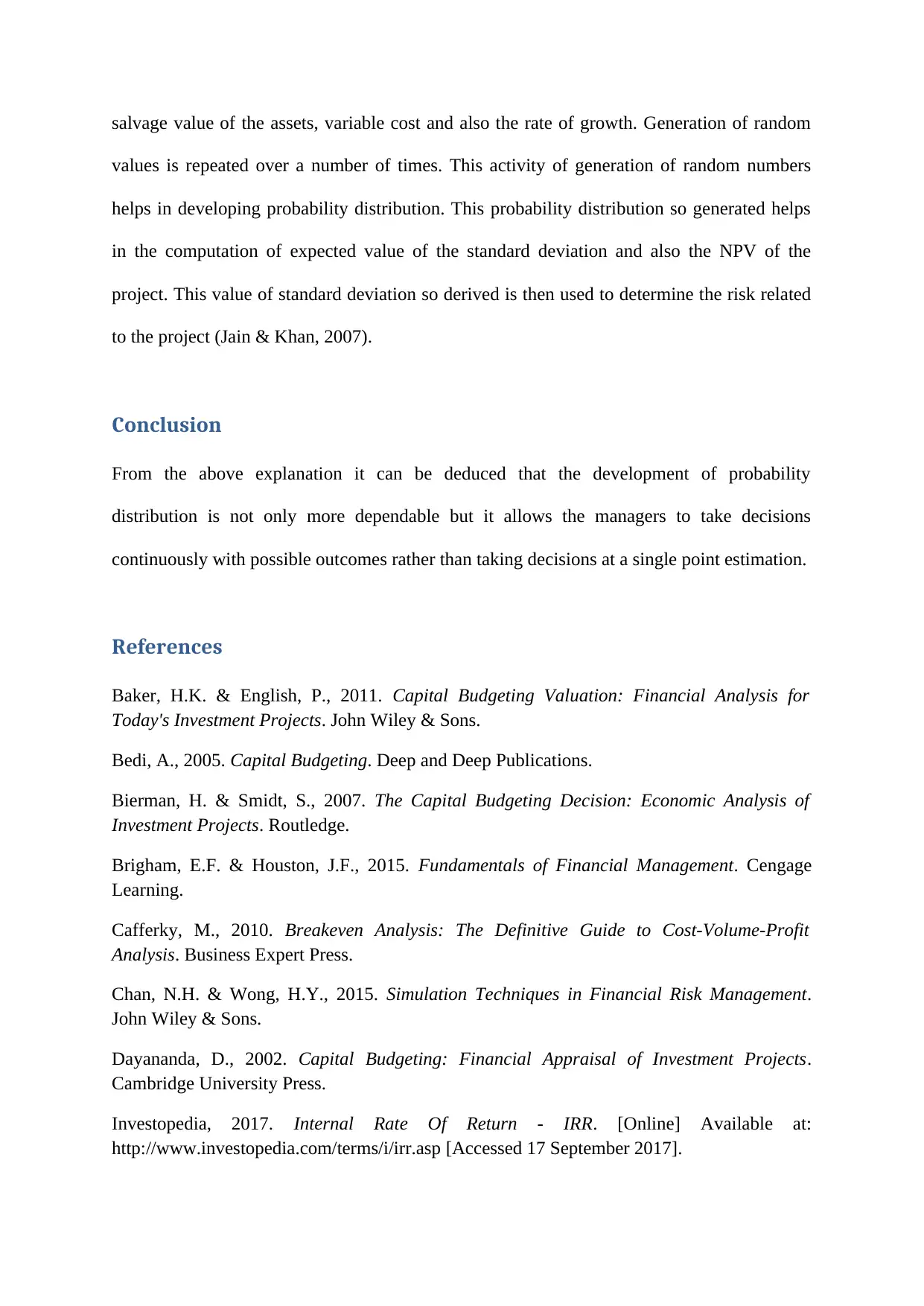
salvage value of the assets, variable cost and also the rate of growth. Generation of random
values is repeated over a number of times. This activity of generation of random numbers
helps in developing probability distribution. This probability distribution so generated helps
in the computation of expected value of the standard deviation and also the NPV of the
project. This value of standard deviation so derived is then used to determine the risk related
to the project (Jain & Khan, 2007).
Conclusion
From the above explanation it can be deduced that the development of probability
distribution is not only more dependable but it allows the managers to take decisions
continuously with possible outcomes rather than taking decisions at a single point estimation.
References
Baker, H.K. & English, P., 2011. Capital Budgeting Valuation: Financial Analysis for
Today's Investment Projects. John Wiley & Sons.
Bedi, A., 2005. Capital Budgeting. Deep and Deep Publications.
Bierman, H. & Smidt, S., 2007. The Capital Budgeting Decision: Economic Analysis of
Investment Projects. Routledge.
Brigham, E.F. & Houston, J.F., 2015. Fundamentals of Financial Management. Cengage
Learning.
Cafferky, M., 2010. Breakeven Analysis: The Definitive Guide to Cost-Volume-Profit
Analysis. Business Expert Press.
Chan, N.H. & Wong, H.Y., 2015. Simulation Techniques in Financial Risk Management.
John Wiley & Sons.
Dayananda, D., 2002. Capital Budgeting: Financial Appraisal of Investment Projects.
Cambridge University Press.
Investopedia, 2017. Internal Rate Of Return - IRR. [Online] Available at:
http://www.investopedia.com/terms/i/irr.asp [Accessed 17 September 2017].
values is repeated over a number of times. This activity of generation of random numbers
helps in developing probability distribution. This probability distribution so generated helps
in the computation of expected value of the standard deviation and also the NPV of the
project. This value of standard deviation so derived is then used to determine the risk related
to the project (Jain & Khan, 2007).
Conclusion
From the above explanation it can be deduced that the development of probability
distribution is not only more dependable but it allows the managers to take decisions
continuously with possible outcomes rather than taking decisions at a single point estimation.
References
Baker, H.K. & English, P., 2011. Capital Budgeting Valuation: Financial Analysis for
Today's Investment Projects. John Wiley & Sons.
Bedi, A., 2005. Capital Budgeting. Deep and Deep Publications.
Bierman, H. & Smidt, S., 2007. The Capital Budgeting Decision: Economic Analysis of
Investment Projects. Routledge.
Brigham, E.F. & Houston, J.F., 2015. Fundamentals of Financial Management. Cengage
Learning.
Cafferky, M., 2010. Breakeven Analysis: The Definitive Guide to Cost-Volume-Profit
Analysis. Business Expert Press.
Chan, N.H. & Wong, H.Y., 2015. Simulation Techniques in Financial Risk Management.
John Wiley & Sons.
Dayananda, D., 2002. Capital Budgeting: Financial Appraisal of Investment Projects.
Cambridge University Press.
Investopedia, 2017. Internal Rate Of Return - IRR. [Online] Available at:
http://www.investopedia.com/terms/i/irr.asp [Accessed 17 September 2017].
⊘ This is a preview!⊘
Do you want full access?
Subscribe today to unlock all pages.

Trusted by 1+ million students worldwide
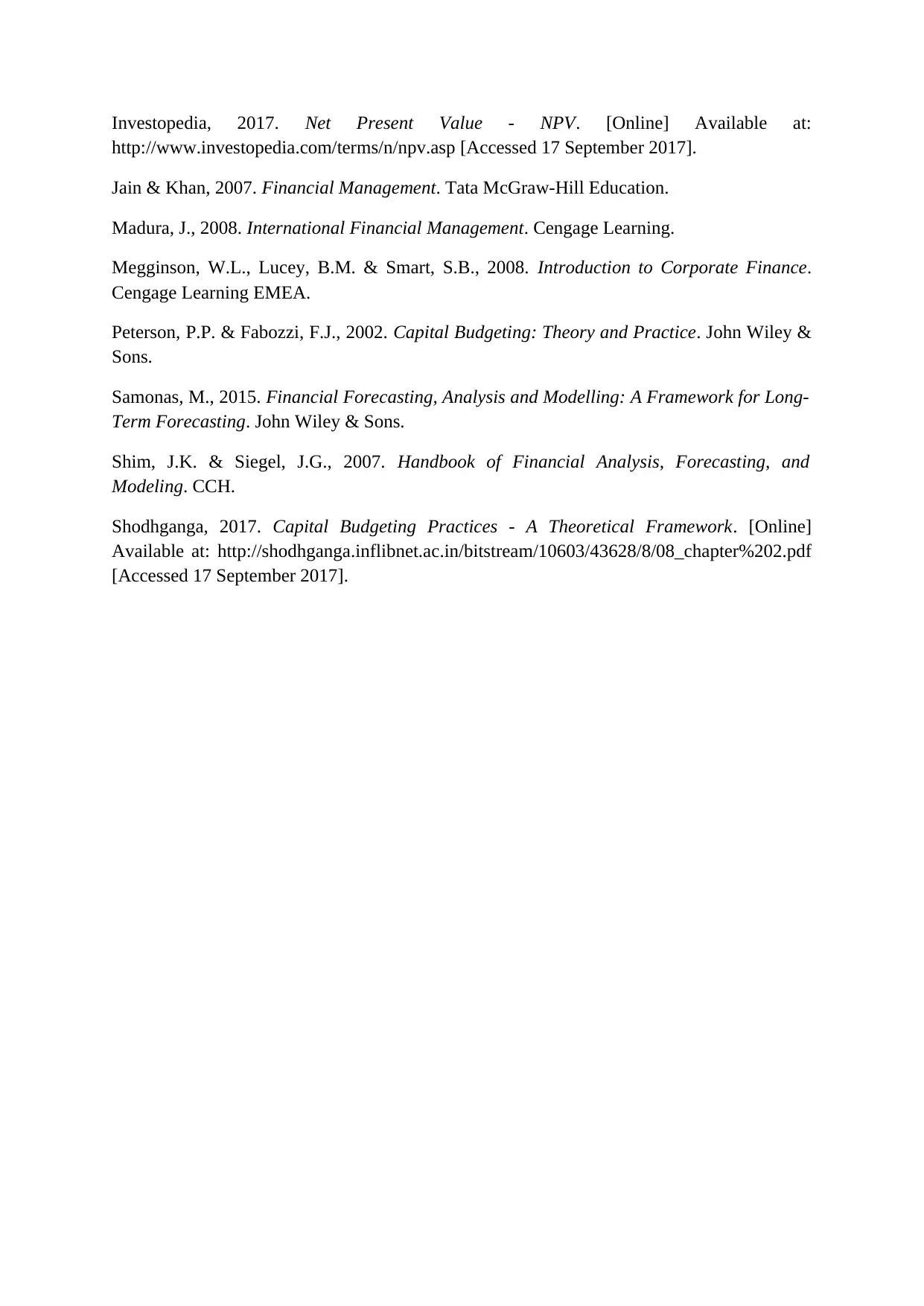
Investopedia, 2017. Net Present Value - NPV. [Online] Available at:
http://www.investopedia.com/terms/n/npv.asp [Accessed 17 September 2017].
Jain & Khan, 2007. Financial Management. Tata McGraw-Hill Education.
Madura, J., 2008. International Financial Management. Cengage Learning.
Megginson, W.L., Lucey, B.M. & Smart, S.B., 2008. Introduction to Corporate Finance.
Cengage Learning EMEA.
Peterson, P.P. & Fabozzi, F.J., 2002. Capital Budgeting: Theory and Practice. John Wiley &
Sons.
Samonas, M., 2015. Financial Forecasting, Analysis and Modelling: A Framework for Long-
Term Forecasting. John Wiley & Sons.
Shim, J.K. & Siegel, J.G., 2007. Handbook of Financial Analysis, Forecasting, and
Modeling. CCH.
Shodhganga, 2017. Capital Budgeting Practices - A Theoretical Framework. [Online]
Available at: http://shodhganga.inflibnet.ac.in/bitstream/10603/43628/8/08_chapter%202.pdf
[Accessed 17 September 2017].
http://www.investopedia.com/terms/n/npv.asp [Accessed 17 September 2017].
Jain & Khan, 2007. Financial Management. Tata McGraw-Hill Education.
Madura, J., 2008. International Financial Management. Cengage Learning.
Megginson, W.L., Lucey, B.M. & Smart, S.B., 2008. Introduction to Corporate Finance.
Cengage Learning EMEA.
Peterson, P.P. & Fabozzi, F.J., 2002. Capital Budgeting: Theory and Practice. John Wiley &
Sons.
Samonas, M., 2015. Financial Forecasting, Analysis and Modelling: A Framework for Long-
Term Forecasting. John Wiley & Sons.
Shim, J.K. & Siegel, J.G., 2007. Handbook of Financial Analysis, Forecasting, and
Modeling. CCH.
Shodhganga, 2017. Capital Budgeting Practices - A Theoretical Framework. [Online]
Available at: http://shodhganga.inflibnet.ac.in/bitstream/10603/43628/8/08_chapter%202.pdf
[Accessed 17 September 2017].
1 out of 10
Related Documents
Your All-in-One AI-Powered Toolkit for Academic Success.
+13062052269
info@desklib.com
Available 24*7 on WhatsApp / Email
![[object Object]](/_next/static/media/star-bottom.7253800d.svg)
Unlock your academic potential
Copyright © 2020–2025 A2Z Services. All Rights Reserved. Developed and managed by ZUCOL.



